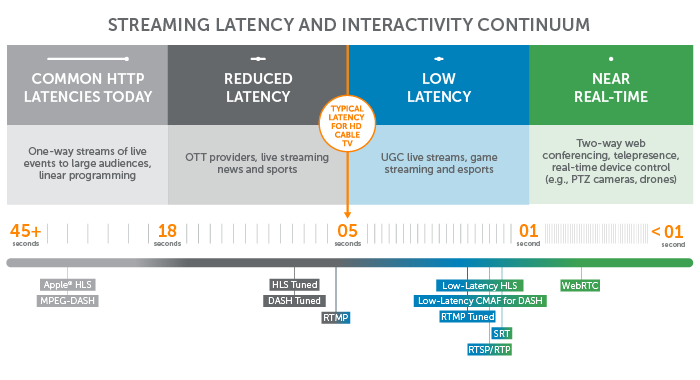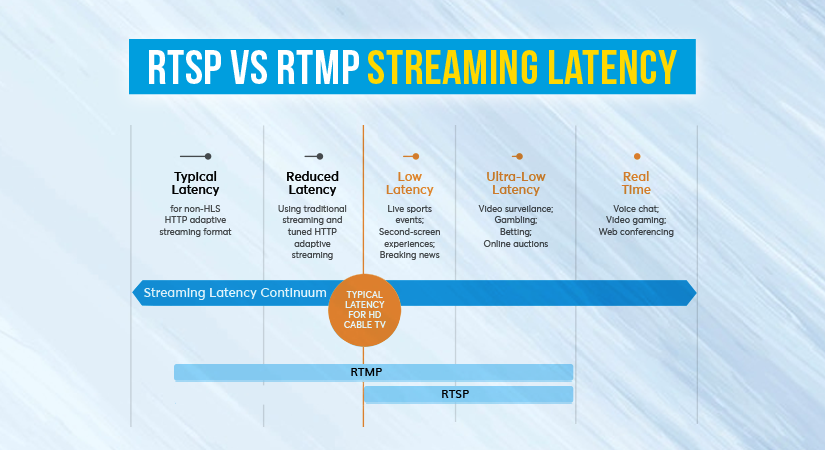RTSP is used for streaming media in real-time, while HTTP is used for transferring web pages and files. Both protocols serve different purposes in web and media environments.
RTSP (Real-Time Streaming Protocol) is designed specifically for streaming audio and video in real-time. It allows for interactive control of the streaming media, such as pausing, playing, and recording. HTTP (Hypertext Transfer Protocol), on the other hand, is the foundation of data communication on the web, used primarily for loading web pages and transferring files.
RTSP provides low latency, making it ideal for live broadcasts and video conferencing. HTTP is more versatile and widely used for general web browsing and downloading. Understanding these differences helps in choosing the right protocol for your specific needs.

Understanding Rtsp
Understanding RTSP is crucial for anyone dealing with streaming media. Whether you’re streaming live events or setting up a security system, knowing RTSP can make a big difference. Let’s dive into what RTSP is, its key features, and common use cases.
What Is Rtsp?
RTSP stands for Real-Time Streaming Protocol. This protocol helps in controlling streaming media servers. It allows clients to remotely control a streaming media server. RTSP is used for establishing and controlling media sessions between endpoints. It is a network control protocol designed for use in entertainment and communications systems.
Key Features Of Rtsp
- Real-Time Control: RTSP allows real-time control of media streams.
- Scalability: Supports multiple clients and servers.
- Interactivity: Allows users to pause, play, and record.
- Low Latency: Ensures minimal delay in media streaming.
- Compatibility: Works with various media formats and devices.
Common Use Cases
| Use Case | Description |
|---|---|
| Live Streaming | Used for broadcasting live events. |
| Security Cameras | Streams video from security cameras to monitors. |
| Video Conferencing | Facilitates real-time video communications. |
| Online Education | Streams educational content to students. |
Delving Into Http
HTTP, or Hypertext Transfer Protocol, is the backbone of web communication. Understanding its features, uses, and importance can offer insights into its widespread adoption. Let’s delve into HTTP to see why it stands out.
What Is Http?
HTTP stands for Hypertext Transfer Protocol. It is the foundation of data communication for the World Wide Web. HTTP is a protocol used to transfer data over the internet. It allows web browsers and servers to communicate efficiently.
HTTP operates on a request-response model. A client sends a request to the server, and the server responds with the requested data. This simple process enables seamless web browsing.
Key Features Of Http
- Stateless Protocol: Each request is independent and does not rely on previous requests.
- Extensible: New features and methods can be added easily.
- Connectionless: The client and server only connect when needed.
- Flexible: It supports various types of media, like text, images, and videos.
Common Use Cases
HTTP is widely used for various applications on the web:
- Web Browsing: HTTP is essential for loading web pages.
- APIs: Many web services use HTTP for API communication.
- File Transfer: HTTP is used to download and upload files.
- Media Streaming: HTTP is used for streaming audio and video content.
HTTP’s simplicity and flexibility make it the standard for web communication. Its key features and common use cases illustrate its importance in everyday internet activities.
Performance Comparison
Choosing between RTSP and HTTP for video streaming involves performance considerations. This section compares their performance based on latency and speed as well as reliability and stability.
Latency And Speed
Latency is the time it takes for data to travel from source to destination. Speed is how quickly data is transmitted.
| Aspect | RTSP | HTTP |
|---|---|---|
| Latency | Low | High |
| Speed | Fast | Moderate |
RTSP offers lower latency. This is crucial for live streaming. HTTP has higher latency because it uses buffering.
Reliability And Stability
Reliability means consistent performance. Stability is how well the system handles errors.
| Aspect | RTSP | HTTP |
|---|---|---|
| Reliability | High | Moderate |
| Stability | High | High |
RTSP is reliable for real-time applications. HTTP provides stability, especially with content delivery networks (CDNs).

Security Considerations
Security is crucial for streaming protocols. RTSP and HTTP have different security features. Understanding these can help you choose the right protocol.
Rtsp Security Features
RTSP stands for Real-Time Streaming Protocol. It is mainly used for streaming media. It offers several security features:
- Authentication: RTSP supports basic and digest authentication.
- Encryption: RTSP can use SSL/TLS for secure transmission.
- Access Control: RTSP allows for IP-based access control.
RTSP’s authentication features ensure only authorized users can access the stream. Encryption protects the data from eavesdropping. Access control further restricts unauthorized access.
Http Security Features
HTTP stands for Hypertext Transfer Protocol. It is widely used for web communications. HTTP also has important security features:
- HTTPS: HTTP can use SSL/TLS, becoming HTTPS.
- Authentication: HTTP supports various authentication methods.
- Firewalls: HTTP traffic can be filtered by firewalls easily.
Using HTTPS ensures data is encrypted during transmission. Multiple authentication methods help in verifying user identities. Firewalls can monitor and filter HTTP traffic to improve security.
Scalability Factors
Scalability is crucial in streaming video. Both RTSP and HTTP have unique scalability factors. Understanding these factors helps in choosing the right protocol for your needs.
Rtsp Scalability
RTSP (Real-Time Streaming Protocol) excels in low-latency streaming. It is ideal for live broadcasts. RTSP handles many connections efficiently. It uses minimal server resources. This makes it suitable for large audiences.
RTSP servers can distribute load across multiple servers. This enhances scalability. Here are some key points:
- Low latency
- Efficient resource usage
- Load distribution
RTSP’s design supports real-time communication. This is vital for interactive applications.
Http Scalability
HTTP (Hypertext Transfer Protocol) is widely used for video streaming. It is well-suited for on-demand content. HTTP scales easily with existing web infrastructure. This includes CDNs (Content Delivery Networks).
HTTP can handle a large number of requests. It uses standard web servers. This makes it simple to scale. Consider these points:
- Leverages existing web infrastructure
- Utilizes CDNs for scalability
- Handles many requests
HTTP’s ability to cache content enhances scalability. It reduces server load. This is beneficial for popular videos.
Cost Implications
Choosing between RTSP and HTTP for streaming can impact your budget. This section will explore the cost implications of both protocols. We’ll focus on three key areas: implementation costs, maintenance, and operational costs.
Implementation Costs
RTSP typically requires specialized hardware and software. This can increase initial expenses. You may need to purchase dedicated RTSP servers. These servers support real-time streaming.
On the other hand, HTTP uses standard web servers. These servers are generally more affordable. Most businesses already have web servers. This can reduce implementation costs.
| Cost Factor | RTSP | HTTP |
|---|---|---|
| Server Requirements | Specialized RTSP servers | Standard web servers |
| Initial Setup | Higher | Lower |
Maintenance And Operational Costs
RTSP systems often need more maintenance. They require regular updates and monitoring. This can increase operational expenses over time.
HTTP solutions are easier to maintain. They leverage existing web infrastructure. This makes them cost-effective in the long run.
- RTSP: Higher maintenance costs
- HTTP: Lower maintenance costs
Both protocols have unique cost implications. Consider these factors to make an informed decision.
Choosing The Right Protocol
Choosing the right protocol for streaming is vital. It affects quality, speed, and compatibility. RTSP and HTTP are two common protocols. Each has its strengths and weaknesses.
Factors To Consider
Consider these factors when choosing between RTSP and HTTP:
- Latency: RTSP offers low latency, making it ideal for live streaming.
- Compatibility: HTTP is widely compatible with many devices and browsers.
- Quality: RTSP often provides better video and audio quality.
- Complexity: HTTP is simpler to implement and use.
- Bandwidth: RTSP can be more efficient with bandwidth.
Use Case Scenarios
Different scenarios require different protocols. Below are some examples:
| Use Case | Recommended Protocol |
|---|---|
| Live Streaming | RTSP |
| Video on Demand (VOD) | HTTP |
| Surveillance Cameras | RTSP |
| Web-Based Video Playback | HTTP |
RTSP is best for low-latency needs. HTTP is easier and more compatible.

Future Trends
The world of streaming protocols is always changing. With new technologies, the way we stream content evolves. Let’s explore the future trends of RTSP and HTTP.
Evolving Technologies
Evolving technologies play a big role in streaming. 5G networks are one of the most important changes. They promise faster speeds and lower latency. This can improve both RTSP and HTTP streaming.
Artificial Intelligence (AI) is another key player. AI can predict user behavior. This helps in optimizing streaming quality. Both RTSP and HTTP can benefit from this.
Edge computing is also on the rise. It brings data processing closer to the user. This reduces delay and improves the streaming experience. Both protocols can use edge computing to their advantage.
Predictions For Streaming Protocols
Experts have several predictions for streaming protocols. Here are a few:
| Prediction | Impact on RTSP | Impact on HTTP |
|---|---|---|
| Increased use of AI | Improved video quality | Enhanced user experience |
| Growth of 5G | Faster live streaming | Quicker content delivery |
| Edge computing adoption | Lower latency | More efficient data processing |
RTSP might see a rise in live events. HTTP could dominate in on-demand services. Both have their unique strengths. Understanding these trends helps in choosing the right protocol for your needs.
Frequently Asked Questions
What Is The Difference Between Rtsp And Http?
RTSP is used for real-time streaming, while HTTP is for general web data transfer. RTSP allows for low-latency streaming, making it ideal for live broadcasts. HTTP, however, is more versatile and widely supported for web content.
Which Is Better For Streaming, Rtsp Or Http?
RTSP is better for real-time, low-latency streaming. HTTP is more suitable for buffered video playback. Choose RTSP for live events, and HTTP for on-demand video.
Can Rtsp Be Used Over Http?
Yes, RTSP can be tunneled over HTTP. This helps in bypassing firewalls and NAT restrictions. It’s a common method to ensure compatibility with HTTP-based networks.
Is Rtsp More Secure Than Http?
RTSP and HTTP have different security focuses. HTTP often uses HTTPS for encryption. RTSP can also be secured, but it’s less common. Both can be secured with proper configurations.
Conclusion
Choosing between RTSP and HTTP depends on your streaming needs. RTSP is ideal for real-time applications. HTTP suits on-demand content. Evaluate your requirements and infrastructure. Both protocols have their strengths. Make an informed decision to enhance your streaming experience. Understanding these differences ensures optimal performance.



